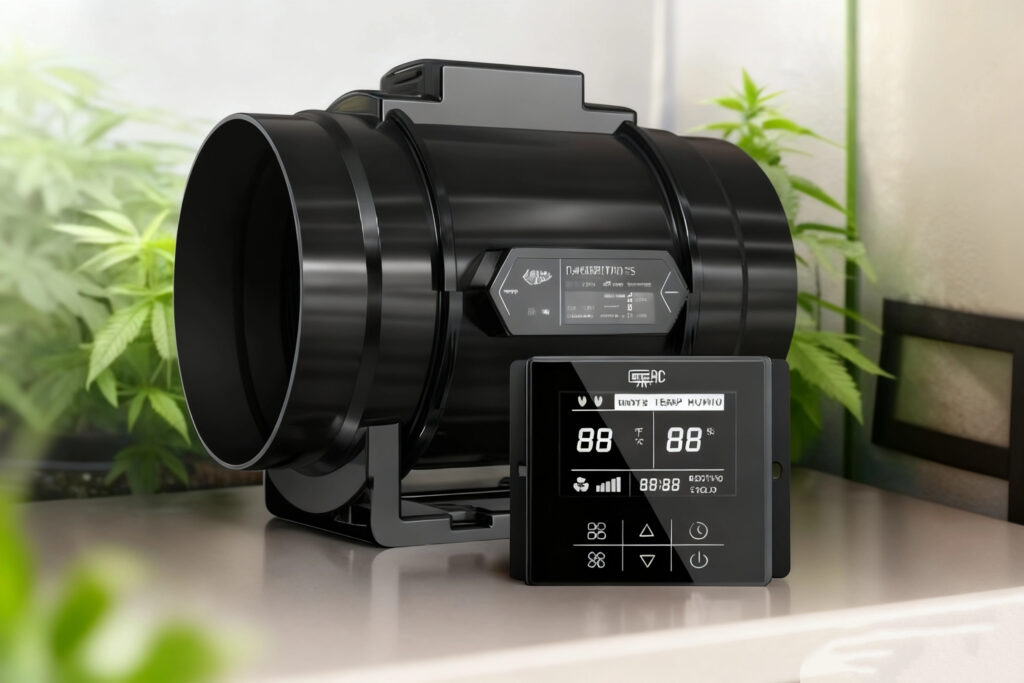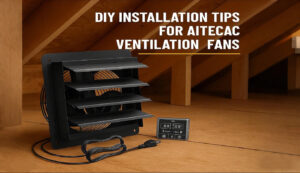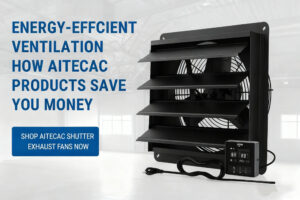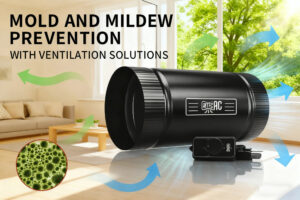Airflow is one of the most overlooked aspects of indoor gardening. Whether you’re growing herbs, vegetables or flowering plants, a grow tent without good ventilation is a recipe for disaster: heat stress, high humidity, pests and mold. An inline duct fan is the heart of your grow tent’s air exchange system. It removes hot, humid air, brings in fresh CO₂ and helps maintain the perfect climate.
Choosing the wrong fan can lead to poor growth, higher electricity bills or even crop failure. This article explains why an inline duct fan is important, what to consider before buying and how to match the right size and power to your grow tent.
What is an Inline Duct Fan?
An inline duct fan is a cylindrical fan installed inside ducting to move air in and out of the grow tent. Unlike clip-on oscillating fans that only circulate air inside, inline fans actively exchange indoor air with fresh air from outside.
There are several designs to choose from:
- Axial Fans: Best for short duct runs with minimal resistance. Affordable but lower pressure.
- Centrifugal Fans: Generate higher static pressure, perfect for longer ducts or when paired with filters.
- Mixed-Flow Fans: Combine the efficiency of the axial with the pressure capacity of centrifugal fans.
For growing tents, mixed-flow fans are often the most popular choice because they offer a good balance of power, noise control and efficiency.

Why Inline Duct Fans Are Important for Grow Tents
Indoor grow tents provide a controlled environment for plants but also trap heat, humidity and odors. If not managed properly:
- Heat buildup: Grow lights can raise the temperature quickly.
- Stagnant air: Plants need fresh air to thrive.
- Excess moisture – High humidity can lead to mold growth.
An inline duct fan solves all of these issues by removing stale air from the tent and pulling fresh air in. This maintains the perfect temperature, improves CO₂ exchange and prevents fungal problems. In short, a fan is the “lungs” of your grow tent.
Things to Consider When Choosing an Inline Duct Fan
Choosing the right fan isn’t just about picking the first one you find online. You need to consider several important factors to make sure it works for your setup.
1. Airflow (CFM) and Tent Volume
Airflow is measured in CFM, which stands for Cubic Feet per Minute. This tells you how much air a fan can move in a single minute. To calculate your needs, find the internal volume of your grow tent by multiplying its length, width and height. As a general rule, you want at least one to two air exchanges per minute or more if you are growing in a hot climate.
For example, a 4 × 4 × 6 foot tent equals 96 cubic feet, so you would need at least 96 to 192 CFM. If you are using long ducting or carbon filters, add 20–30% more capacity to compensate. A properly sized fan prevents heat and humidity while avoiding wasted energy or excess noise from an oversized unit.
2. Duct Size and Compatibility
Matching your fan’s inlet and outlet to your ducting size is key to maintaining proper airflow. Most grow tents use common duct sizes such as 4, 6 or 8 inches and using the correct size prevents backpressure that reduces airflow efficiency. If your duct is too narrow for the fan outlet, airflow will be restricted. Also try to avoid too many bends or sharp turns in your ducting as each bend reduces airflow performance. Always make sure the fan you select is compatible with your existing ducting setup.
3. Noise Level and Vibration
Noise can be a big issue, especially if your grow tent is in a living space or shared area. When comparing fans, check their decibel (dB) ratings at maximum speed as a lower rating means quieter operation. Fans with mixed-flow or EC motors are generally quieter than basic axial fans due to their design. To further minimize noise you can install anti-vibration mounts, rubber grommets or duct silencers. The goal is to have strong airflow without disruptive noise.
4. Motor Type and Durability
The motor inside the fan is the heart so durability is key. AC motors are common and reliable but EC or DC motors are more energy efficient and have better speed control. Look for fans with quality ball bearings, maintenance free designs and thermal protection for long term performance. If you plan to run your fan continuously consider a commercial or industrial grade option that is designed to handle heavy sustained use without failure.
5. Speed, Temperature and Humidity Control
A fan with a speed controller allows you to adjust airflow according to the plant’s growth stage or the surrounding climate. During the vegetative stage lower airflow may be enough while flowering often requires stronger ventilation. Advanced setups use temperature and humidity controllers that automate fan operation.
If heat or humidity rises above set levels the fan automatically speeds up. Some advanced fans have built-in sensors or support external controllers allowing fully automated environmental management.
6. Build Materials and Corrosion Resistance
Grow tents are humid environments so choosing a fan built with corrosion resistant materials is important for longevity. Fans made of galvanized steel, powder coated metal or ABS plastic are ideal as they resist rust and moisture damage. Look for models with UV resistant housings, tight sealing and safe wiring for consistent performance. High IP ratings also indicate better water resistance which can be beneficial in a humid grow space.
7. Power Consumption and Efficiency
Lastly, consider the fan’s efficiency and energy usage. A fan should provide sufficient airflow while consuming as little energy as possible. Look at the wattage at different speeds instead of just maximum power. Efficient designs with optimized blades reduce drag, improve airflow and keep the motor cooler. Not only does this save you money on electricity but it also minimizes heat output from the fan itself making it easier to maintain a stable grow tent environment.

Why Choose the CloudStorm T8 Inline Duct Fan
The CloudStorm T8 Inline Duct Fan is a great choice for anyone who wants a quiet and reliable way to keep their grow tent or indoor space fresh. Here’s why:
- Strong Airflow: The CloudStorm T8 delivers 830 CFM of airflow which means it can refresh the air in your grow tent or room very quickly. Its mixed-flow design and PWM controlled DC motor makes it energy efficient and easy to adjust for your exact needs.
- Quiet: 38 dB, as quiet as a soft conversation. Use it in your grow tent, office, bedroom or basement without being disturbed by loud noise.
- Temperature & Humidity Control: This fan does more than just move air. It comes with a temperature and humidity controller. It can automatically adjust to keep your plants in the best environment.
- Works in Many Spaces: CloudStorm T8 isn’t just for growing tents. Use it to improve airflow in hydroponic rooms, kitchens, basements, workshops or equipment rooms. It removes heat, humidity and unwanted smells wherever you need it.
- Reliable and Protected: Aitecac gives you 2 years of after-sales service. If something goes wrong their support team is ready to help. This gives you peace of mind with your purchase.
This fan is for growers who need quiet ventilation for sensitive environments like apartments or shared spaces. Get the CloudStorm T8 Inline Duct Fan for $169 and have fresh air, healthy plants and worry free.
Conclusion: Choose the Right for Your Grow Tent
Choosing the right inline duct fan is an investment in your grow tent’s success. The right fan maintains optimal temperature, humidity and CO₂ levels and results in healthier plants and bigger yields. If you’re ready to upgrade your ventilation system get the CloudStormT8 Quiet 8″ Inline Duct Fan. It’s powerful, quiet and built for serious growers who want professional results.
Take your grow tent to the next level with a reliable ventilation setup. Browse Aitecac’s full range of inline duct fans today and create the perfect growing environment for your plants!





